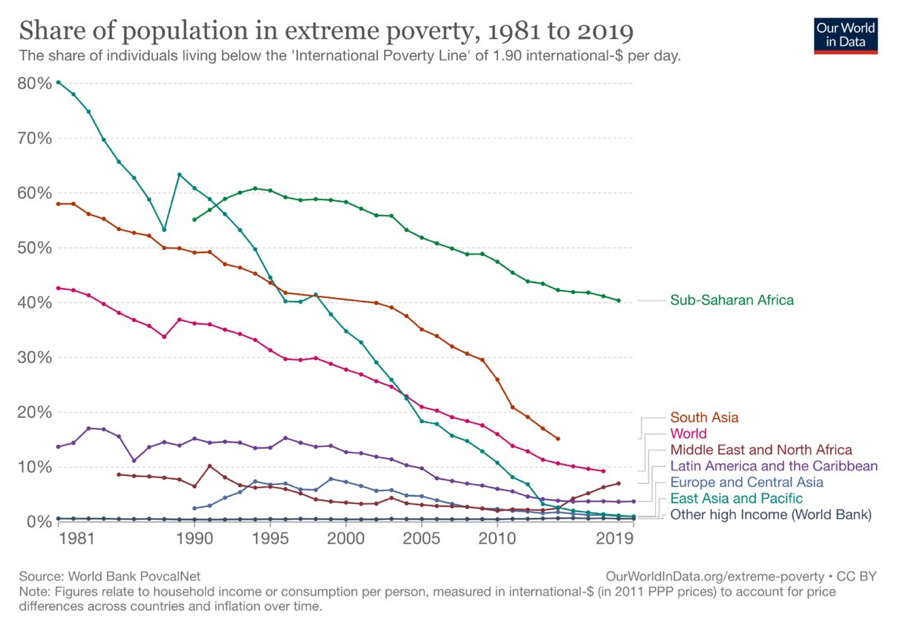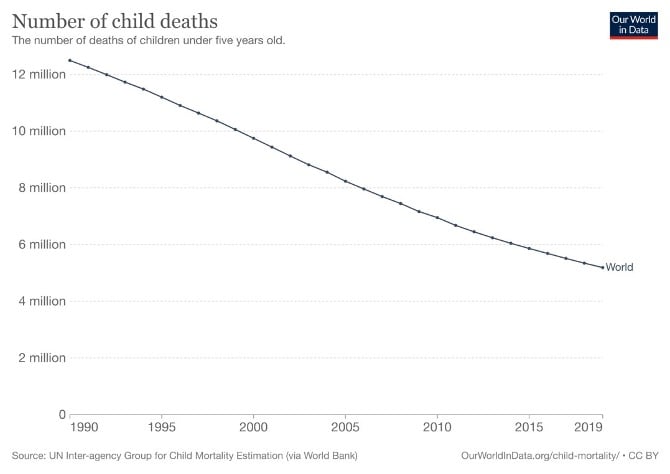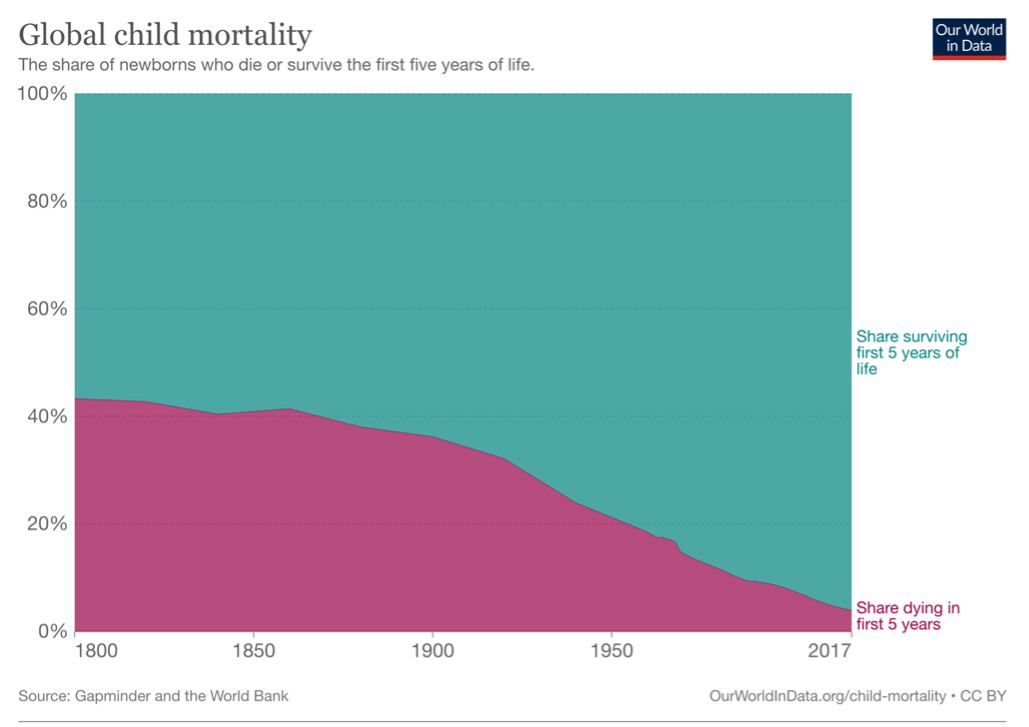
The world is getting better on many critical and measurable fronts.
But as I discussed earlier in this series, many of us can’t see this good news because we’re constantly bombarded with dystopian stories.
Over the next few blogs, I’ll show you what I call evidence of abundance.
Today, we’ll look at how technology is helping to reduce poverty and child mortality.
Before we get started, I want to acknowledge something: while the world is indeed getting better on many fronts, there is no question that we still face many challenges—from ongoing wars and the climate crisis to species extinction and continued inequalities. (We’ll discuss these challenges in more detail in upcoming blogs in this series.)
It’s also worth noting that you may get pushback from friends and family as you talk about a hopeful and abundant future.
That’s OK. Show them the data.
We truly are living in the most exciting time ever to be alive—whether those around us choose to believe it or not.
Thankfully, we are alive during a time when each of us has the tools, should we choose to use them, to solve the problems that can make the world a better place.
Let’s dive in...
Extreme Poverty is Declining
Dr. Hans Rosling was a Swedish physician and academic dedicated to helping people develop what I call “data-driven optimism.” During the course of his career and travels, he would ask his audiences seemingly innocent questions that in reality were intended to expose our inherent negativity bias.
One such question he asked thousands of people over the years was the following:
“Has the percentage of the world population that lives in extreme poverty doubled, halved, or stayed the same over the past 20 years?”
The answer from audiences around the world was very telling.
About 65% of people in America, and a similar percentage in the UK, answered that the percentage of the world’s population living in extreme poverty has doubled in 20 years.
5% say it’s halved.
The 5% are right, and the 65% are wrong.
But it’s what he said next that was so brilliant: if he had written those same 3 answers (doubled, halved, stayed the same) on 3 bananas and thrown them into a cage with a monkey in it, the monkey would have picked up the correct answer 33% of the time—not 5% of the time.
So, it’s 6x as good as us at understanding the opportunities that we have as human beings.
That tells us something: we’re not just ignorant about the world, we’re actively knowledgeable and wrong.
There’s a wonderful quote from Josh Billings, the 19th century American sage:
“It ain’t what you don’t know that gets you into trouble. It’s what you know for sure that ain’t so.”
Looking back beyond 20 years, to the last 40, the data is even more compelling.

A great example is the number of people in East Asia and the Pacific living in extreme poverty, which has dropped from 80% to under 5%.
Globally the number dropped from 42% in 1980 to under 10% in 2019.
Looking at the data, it’s shocking how consistent this downward trend in extreme poverty has been.
Ask yourself, why is this happening? Why are we seeing these—and so many more—positive trends? Is it new government policies? Are people getting smarter?
Or, as we explored previously in this series, is it the impact of globally digitized, dematerialized, demonetized, and democratized technologies?
Child Mortality is Falling
What could be more precious than a child’s life?
As a parent of twin boys and as someone trained as an MD, I believe that the dramatic decline in child mortality is one of society’s most remarkable achievements this century.
Since 1990, child mortality has decreased by more than 50 percent! We can expect this trend to continue due to advances in technology.
Just a few decades ago in 1990, over 12 million children worldwide under the age of 5 would perish. By 2020, that number had been reduced to just over 5 million children. Still way too many, but we’re moving in the right direction.

Below is an even more impressive view at the progress we’ve made in reducing child mortality over time. The global average child mortality rate (with population weighted) was as an astonishing 43.3% in 1800, and thankfully fell to just 3.4% by 2013.

Why This Matters
This data-driven optimism is one of the key underlying reasons why I’m optimistic about the future despite the background sentiment of pessimism.
How does it make you feel?
This is just a taste of all the progress we’ve made due to rapidly developing technologies.
In our next blog, we’ll see even more evidence of abundance, including the rising number of democracies and increasing literacy rates.
Abundance360 Member Moonshot Highlight
Rick Smith is the Founder and CEO of Axon, which makes the TASER.
Rick's journey began 3 decades ago in a garage, sparked by personal loss and a desire to address the issue of gun violence from a technological perspective. His inspiring resolve led him to our community at Abundance360, where we have been fortunate enough to witness his vision grow into an impactful Moonshot.
During his talk from the Abundance360 Summit stage, Rick shared his ambitious and tangible goal: to reduce gun-related deaths between the police and the public by 50% over the next 10 years. With gun-related deaths currently rising about 2% per year, Rick and his team have set their sights on a challenging but profoundly important objective.
Key to achieving this Moonshot is a three-pronged strategy combining innovative technology, advanced training, and data-driven outcomes. Rick introduced the TASER 10, a next-generation weapon designed to be as effective as a traditional handgun but without the lethal consequences. This groundbreaking tool utilizes an electric signal transmitted through small electrical connectors to incapacitate targets safely.
Moreover, Rick revealed ongoing efforts to integrate drones and robotics to address up to 72% of police shootings, working on ethical frameworks alongside technology development to ensure public acceptance and safety.
Rick's Moonshot vision has already rallied support from both sides of the political spectrum in the US, uniting the Fraternal Order of Police and the African-American Mayors Association towards the common goal of reducing police shootings.
At Abundance360, we are immensely proud of our members like Rick who leverage technology to address pressing societal issues.
If you are interested in being part of a community committed to making a difference in the world, we would love to hear from you.
I discuss pursuing Moonshots and creating a more abundant future on my podcast. Here's a conversation I recently enjoyed.
A Statement From Peter:
My goal with this newsletter is to inspire leaders to play BIG. If that’s you, thank you for being here. If you know someone who can use this, please share it. Together, we can uplift humanity.
Topics: Abundance Entrepreneurship Abundance 360



.png?width=331&height=80&name=Layer_1%20(1).png)
-1.png?width=318&height=77&name=Layer_1%20(1)-1.png)





